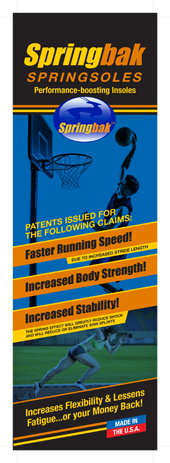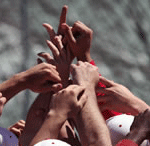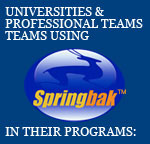Archive for Running Tips
Triathlon Training tips by Springbak: Making an Efficient Transition
Posted by: | Comments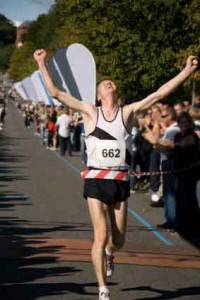 Most triathletes spend the bulk of their training time focused on the three events: swimming, cycling, and running. But the transition between each event also requires training. Each triathlon has two transitions: a swim-to-bike and a bike-to-run. Although they seem simple a poor transition can add precious time and waste energy during a race. A good transition can improve your position and spirits while a bad one can leave you struggling to make up lost time. Here are some tips to help you prefect your transitions.
Most triathletes spend the bulk of their training time focused on the three events: swimming, cycling, and running. But the transition between each event also requires training. Each triathlon has two transitions: a swim-to-bike and a bike-to-run. Although they seem simple a poor transition can add precious time and waste energy during a race. A good transition can improve your position and spirits while a bad one can leave you struggling to make up lost time. Here are some tips to help you prefect your transitions.
Simplify:
Keep your transitions clean and simple. By this, Springbak means don’t try to do too many things during a transition. Keep the number of tasks to the bare minimum. In a transition, the more you have to do, the more time it takes and the more that can go wrong. During the swim-to-bike transition, the fastest athletes may only put on a helmet and grab their bike to run out. Wear a one-piece racing suit to avoid clothing changes if possible. Some racers leave their shoes attached to the pedals and they put them on while riding. A trick they use is to rubber band the heel loops of the cycling shoes to the bike so that they are right side up. Sunglasses can be looped over the handlebars and put on down the road. Food and drink are already attached to the bike so you can fuel on the road as well.
Multi-task:
If you want to be efficient in the transition, you need to learn how to do a few things at once and keep moving in a seamless, fluid motion. Know what things you can do while running or riding or on the run-up to the transition zone and what you have to do before leaving. Something as small as taking off your cap and goggles, or unzipping your wetsuit on the run-up to the bike can save seconds, putting on your cap and sunglasses as you run is equally efficient. It may seem like these things take little or no time, but this will help keep your momentum for the next event.
Train for Transitions:
It is clear that if you want to get better at transitions, you need to practice them. But many athletes don’t practice this part of the race. A good time to practice is during your regular event training, but a mental walk-through of a transition is also important. Practicing transitions during your regular training will help you feel very comfortable on race days. This sort of practice is also a good time to try new techniques and to see what you can do without. Never try something new on race day.
Footwear Footwear: Springbak sponsors many of the top triathletes in the world. Triathletes use the Springbak Springsoles to get a competitive edge on their competition, as every second counts! Our performance insoles work by giving the runner a much longer stride length and quicker stride frequency. The average runner gains 4-6 inches per stride, so over the course of a marathon or triathlon, you have fewer strides, towards the end of a longer run you still feel fresh, and able to maintain a quick and efficient stride. To understand how Springbak accomplishes this, read our ‘patents’ page. Springbak Springsoles are used in the NFL, MLB, NHL, MLS, Olympic Teams and Top Division I Universities across the USA!
Race Day Set-up:
On race day, you should arrive with enough time to survey the transition area before the race and actually do your run-ups and exits so you know exactly where to go. Lay out your gear and do a test run to make sure everything is where you need it and ready to go. (This is very important) Make sure you can find your bike and know your path in and out. This pre-race check is also a good time to do a mental rehearsal as well. Visualizing your transition will help you deal with any challenges that are not a part of your practiced walk-through.
As you do more and more events, you will find what works best for you, but these tips will help you develop transitions that are efficient so you can save your energy for biking and running.
Sincerely,
Mark Vona – GM Springbak, Inc. ~ Hope you enjoy these training tips, all the best to you, please comment and add any of your personal triathlon tips that work for you as well. Happy running!
Springbak Running Tips For Sprinters
Posted by: | CommentsHow do genetics affect my running ability?
The past two blog posts we have discussed what type of shoes to purchase to prevent injury and for your foot type, now let’s discuss speed!
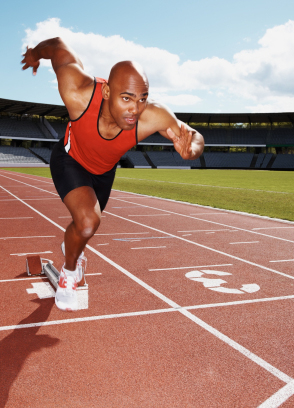 There is a time honored formula for improving running speed: shorten foot-plant time (increase stride frequency) and increase stride length. Let’s discuss a few methods to accomplish both.
There is a time honored formula for improving running speed: shorten foot-plant time (increase stride frequency) and increase stride length. Let’s discuss a few methods to accomplish both.
Speed is perhaps the most coveted component of athletic performance. Whether you are a football player looking to better your 40 yard dash times or a marathoner who wants to improve your distance time, the importance of foot speed in running is unquestionable.
Division I Track and Field programs use our Springbak Springsoles for this very reason. For example, BYU Head Coach, Mark Robison, knows the Springbak Springsoles will accomplish both an increase in stride frequency / stride cadence and an increased stride length for his athletes. All coaches and athletes are seeking a competitive advantage from the equipment they use, to their training programs.
Traditional thinking dictates that to be fast, choose your parents carefully. In other words, speed is a genetic trait. However, while this is true to the extent that it is not possible to be a world class sprinter without genetic endowment, sport science and proper coaching have done much to refute this.
Sprinting speed is an essential element to most sports and a key evaluator of athletic performance. Being geneticly gifted is an important factor that contributes to world-class speed and it cannot be altered period! We need to understand that there are certain individuals that are born with muscular qualities that make them faster simply because of the structural and biochemical properties of their skeletal muscle. However, anyone can increase their speed, just not necessarily to world class athlete status.
The two external factors associated with speed which are trainable are mechanical efficiency (technique) and force production. Mechanical efficiency in sprinting is a skill that must be coached, like swinging a bat, shooting a basketball or throwing a football. When mechanics are perfected, the only way to increase speed is to develop the ability to generate force at greater magnitudes and rates. Sprinting is essentially a game of physics. The athlete who can strike the ground harder and faster, will propel themselves farther down the track, field or court with each step and thus will be faster every time. Talking with world class athletes, Springbak hears the same thing all the time. One of the biggest misconceptions in speed training is that fast sprinters “run light.” In reality, world class sprinters “run violently.” Pound for pound, world-class sprinters are some of the strongest, most powerful athletes in the world and it is that power that separates them from the field.
When watching world class sprinters work out, they shared a lot of training tips, and we are sharing them with you as well. These sprinters use exercises where the foot is in contact with the ground on stable surfaces to develop speed. Because sprinting involves reaction time forces against stable surfaces, sprinting speed is best developed using exercises in which the foot is in contact with the ground and reacts against an immovable surface. Back squats, front squats and deadlifts are exercises that fit into this category. Additionally, the movements in these exercises (extension of the hip, knee, and ankle) are movement specific to the skill of sprinting.
In sprinting, force is generated against the ground on a single leg. Therefore, an ample number of single leg exercises where the foot is in contact with the ground should be incorporated into your program. World class athletes use these methods for a reason – you should too. Lunges, single leg squats and step-ups are all great exercises that can involve triple extension on a single leg and can be used to develop specific sprinting power. Lastly, using plyometrics, or jumping exercises are also great ways to improve sprinting speed. Why? Because plyometrics utilize rapid eccentric and concentric muscle contractions and the forces generated during these exercises are quite similar to sprinting.
Be sure to check the Springbak blog for previous tips and articles!
Article by Mark Vona and Dr. Michael Yessis Phd. – Springbak advisory board.
Visit the Official Springbak® Website at www.springbak.net – Peak Performance Springsoles / Insoles – Run Faster, Jump Higher, Lessen Fatigue
LIKE us on Facebook: www.facebook.com/springbak
Tweet with us on Twitter: www.twitter.com/springbak
Friend us on MySpace: www.myspace.com/springbak
Tune in on YouTube: www.youtube.com/springbakinc
Springbak Running Tips – Proper Running Shoes For Your Foot Type
Posted by: | CommentsJogging gained enormous popularity in the 1970s as a great form of cardiovascular fitness. Since then running has become one of the most popular form of physical fitness in America. Whether you run on an indoor track or outdoors, you can enjoy this activity year-round and fit it comfortably into your daily routine.
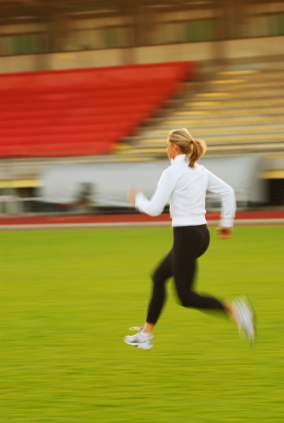 Springbak sponsors many Division I Track and Field programs with high-performance footwear for runners. Our patented Springsoles lengthen your stride length and increase stride frequency, and coaches and trainers endorse our product.
Springbak sponsors many Division I Track and Field programs with high-performance footwear for runners. Our patented Springsoles lengthen your stride length and increase stride frequency, and coaches and trainers endorse our product.
During jogging or running, the 26 bones, 33 joints, 112 ligaments, and a network of tendons, nerves, and blood vessels that make up the foot all work together. That’s why you need to condition your body, build up to a routine, and stretch your muscles, tendons, and ligaments before and after each run. Debilitating muscle strain or more serious injury can result when runners or joggers don’t build up their routines and allow their bodies to strengthen over time.
The most common foot problems associated with jogging or running are: blisters, corns, calluses, Athlete’s Foot, shin splints, Achilles tendonitis, and plantar fasciitis. You can prevent many simple foot problems by using proper foot hygiene. Keep your feet powdered and dry. Wear clean socks every time you run. Make sure your shoes fit properly. Most importantly, let your body be your guide so that you don’t overstrain your legs, ankles, and feet. Always wear Springbak Springsoles in your running or training shoes, these increase athletic performance and give you a competitive edge. At the same time, the Springsoles are a highly effective tool for injury prevention, and great for shin splint problems as well.
Jogging/Running Shoes
Because of the force placed on your legs, ankles, and feet, jogging/running shoes need to provide cushioning for shock absorption. Like walking shoes, you need to select a pair designed for the shape of your foot and your natural foot structure or inclination.
There are three basic foot types:
Pronators are people with relatively flat feet, caused by low arches, which generally leads to over pronation, or a gait in which the ankle rolls inward excessively. People with this foot type need motion control shoes that offer support for mid-foot. Motion-control shoes are more rigid and built on a straight last. These are generally board-lasted shoes, which have a piece of cardboard running the length of the shoe for greater stability. Look for sturdy uppers for added stability and avoid shoes with a lot of cushioning or highly curved toes. Also look for a reinforced heel counter to maintain foot support and stability.
Supinators are people with high arches, which can lead to under pronation that places too much weight on the outsides of the feet. People with this foot type need stability shoes designed for extra shock absorption and often having a curved or semi-curved last. A slip-lasted shoe is also recommended, because the sewn seam runs the length of the shoe giving it greater flexibility. Also look for shoes that are reinforced around the ankle and heel to stabilize the foot and extra cushioning under the ball of the foot.
People with normal feet can wear any type of running shoe, although a curved last is generally preferred. When you run, your foot rolls quickly from the heel to the toe, with your foot bending at the ball on each step. That’s why it is important for running shoes to have enough flexibility in just the right places. However, to help with shock absorption, you need a little more rigidity to support the middle of the foot. Make sure the heel is low, but slightly wider than a walking shoe to help absorb the initial shock when your heel strikes the ground.
Here are some other important tips for buying a good pair of running shoes:
- Shop at the end of the day when your feet are slightly swollen to get a good fit.
- Try on shoes with the socks you will wear when walking. If you use an orthotic, bring that to the store when you try on shoes as well.
- Have your feet measured standing up and fit your shoes to the larger of your two feet.
- Be sure there is enough room in the toe box for your toes to wiggle and about a half inch between your toes and the end of the shoe
- Take time when shopping to try on different brands and walk around the store in each pair. Be sure to walk on a hard surface, not just on carpeting. Let your foot be the guide to the fit, not the shoe size or style.
- Look for lightweight, breathable materials for greater comfort.
- Run your hand all over and inside the shoes to feel for any seams or catches that might irritate your foot.
- Choose shoes that lace for better foot stability and control.
- Make sure your heel fits snugly and does not tend toward slipping out of the shoe.
- Consider buying two pairs and rotating your wear to give each pair time to breath between runs and extend the life of each pair.
- Replace running or jogging shoes twice year or about every 400 miles.
Please feel free to interact and share running tips by entering your comments below. We want to hear for you too!
We hope you have enjoyed our tips – Be sure to check the Springbak blog for previous tips and articles!
– The Team at Springbak, Inc.
Visit the Official Springbak® Website at www.springbak.net – Peak Performance Springsoles / Insoles – Run Faster, Jump Higher, Lessen Fatigue
Find us on Facebook: www.facebook.com/springbak
Follow us on Twitter: www.twitter.com/springbak
Friend us on MySpace: www.myspace.com/springbak
Tune in on YouTube: www.youtube.com/springbakinc
Springbak Speed Training Tips – Plyometrics
Posted by: | Comments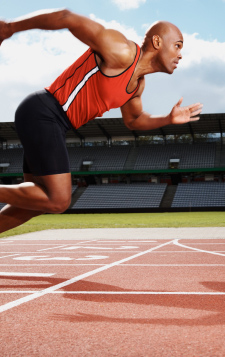 Plyometrics have long been considered a key in developing explosiveness, quickness and speed. Such explosiveness is referred to as “Strength in Motion”. Plyometric training links together strength with speed to create power. It’s essential to athletes, primarily to those who run, jump, lift or throw.
Plyometrics have long been considered a key in developing explosiveness, quickness and speed. Such explosiveness is referred to as “Strength in Motion”. Plyometric training links together strength with speed to create power. It’s essential to athletes, primarily to those who run, jump, lift or throw.
Plyometric training is designed to enable a muscle to reach maximum strength in a short amount of time. This in turn leads to muscles that propel athletes faster, higher and more explosive.
Our patented and proven Springbak Springsoles will give you a competitive advantage as well. The Springsoles will give you a longer stride length, and quicker stride frequency, both necessary to gain speed. Together with plyometric training, this is the combination winning athletes are using today.
There are several types of plyometric training drills—or jumps—which are useful for developing athletic explosiveness. The following are some of the most widely used:
1. Jumps in place—a jump completed by landing in the same spot where the jump started. Low in intensity, yet it provides stimulus by requiring athletes to rebound quickly, jump after jump
2. Standing Jumps—stresses single maximum effort, horizontal or vertical with recovery time between each, and repeated
3. Multiple Hops & Jumps—combination of the above, yet are done one after another
4. Bounding—exaggerated normal running, focusing on lifting and “floating” as you run
5. Box Drills—combines multiple hops and jumps with depth jumps using boxes to land on
6. Depth Jumps—uses athletes body weight and gravity to exert force against ground. Performed by stepping out from box and dropping to ground, then jumping back up to the height of the box
Each type of jump is useful for developing explosiveness in all sports. Add the use of barriers such as cones and hurdles to increase training variety and intensity. Also, add a 5-10 yard sprint after each jump, or the use of a ball (catching, dribbling) to make it more sports specific.
When designing a plyometric training program, a good rule to follow is:
1. Train Plyo’s 2 times a week for beginners
2. Start with relatively low set/rep ratio (3 sets, 8 jumps per set)
3. Give good recovery time between sets for maximum effort
4. Make drills sports specific as possible (Jump/Sprint, Jump/Catch Ball)
Be creative, follow your impulse, and listen to your body. Good Luck!
For more news, tips and information from Springbak:
Visit the Official Springbak® Website at www.springbak.net – Peak Performance Springsoles / Insoles – Run Faster, Jump Higher, Lessen Fatigue
Find us on Facebook: www.facebook.com/springbak
Follow us on Twitter: www.twitter.com/springbak
Friend us on MySpace: www.myspace.com/springbak
Tune in on YouTube: www.youtube.com/springbakinc
Springbak Speed Training Skills – How To Quicken Your Stride Frequency For More Speed
Posted by: | CommentsSpeed is perhaps the most coveted component of athletic performance. Whether you are a football player looking to better your 40 yard dash times or a marathoner who’s looking to improve your distance time, the importance of foot speed in running is unquestionable.
Our patented Springbak Springsoles will accomplish both increased stride frequency and increases stride length.
Traditional thinking dictates that to be fast, choose your parents carefully. In other words, speed is a genetic trait. While this is true to the extent that it is not possible to be a world-class sprinter without genetic endowment, sport science and proper coaching have done much to refute this.
Speed is a learnable skill that can be taught through motor-learning principles. Ultimately, it is only through the practice (repetition) of these motor skills and proper training that any genetic endowment can reach its highest potential.
There is an old axiom: “I hear, I forget; I see, I understand; I do, I remember.” The more you do something, the better you become at it.
Speed Made Simple to understand:
Although the actual physical components of running speed are rather complex, we’re going to keep things simple. Speed is produced by stride length (distance covered with each stride) and stride frequency (leg turnover time, or how quickly you can get your feet on and off the ground).
Of these two components, stride length is the easiest to develop and is also the most misunderstood. Stride length is not created by how far you can reach forward with each step, but rather by the amount of force you apply to the ground (with the foot striking directly under the hip) and driving back. Our Springbak Springsoles will increase the force you apply to the ground, thus a longer stride length.
Speed is created through the ground, not the air. Once the foot touches the ground, it drives rearward, creating a springboard effect that propels the body forward. Most people are slower than they should be because they pull out of their stride length too early, not allowing the foot to remain on the ground long enough to drive the leg completely straight behind the body, thereby maximizing the force and distance necessary to propel the body farther forward.
Let’s quickly look at two basic mechanical principles that should be considered for proper running form:
Step 1: Keep Your Head Steady:
Head position is critical in athletic performance. Your head should be still during sprinting. We use the term “focus” to mean your eyes should be straight ahead, as if you’re looking at somebody your height in the eyes. Remember, you go where your head goes.
If your head is moving side-to-side, your body is going to be subject to lateral forces that negate from the objective: moving straight ahead. You should run relaxed; you’ll hear track coaches say “Jaw down, shoulders down.” The human head generally weighs between 11 and 14 pounds. Keep this “bowling ball” (your head) in the proper postural alignment: centered between the shoulders.
Step 2: Keep Your Arms Fixed at a 90-degree Angle:
Why? To use the strong muscles of the shoulder girdle to create optimum force. Never run with tight, clenched fists. This will tighten you up and slow you down. Keep your thumb and forefinger in contacts or run with an open palm, whichever you are most comfortable with. Your elbows should be squeezed in to the sides of the body.
Try this: Stand up and put your left hand on your left hip. Move your right arm across your body. Did you notice how your left hip moved? The body is a system of levers and, to simplify matters, what you do with one arm will affect the opposite leg. If your arms cross in the mid-line of your body when running, your hips will rotate in, thereby taking away from your force output and creating rotational forces that minimize your speed.
Enjoy the speed training tips!
Mark Vona – GM Springbak Inc.
_______________
For more tips and information from Springbak:
Visit the Official Springbak® Website at www.springbak.net
Peak Performance Springsoles / Insoles – Run Faster, Jump Higher, Lessen Fatigue
Find us on Facebook: www.facebook.com/springbak
Follow us on Twitter: www.twitter.com/springbak
Friend us on MySpace: www.myspace.com/springbak
Tune in on YouTube: www.youtube.com/springbakinc


